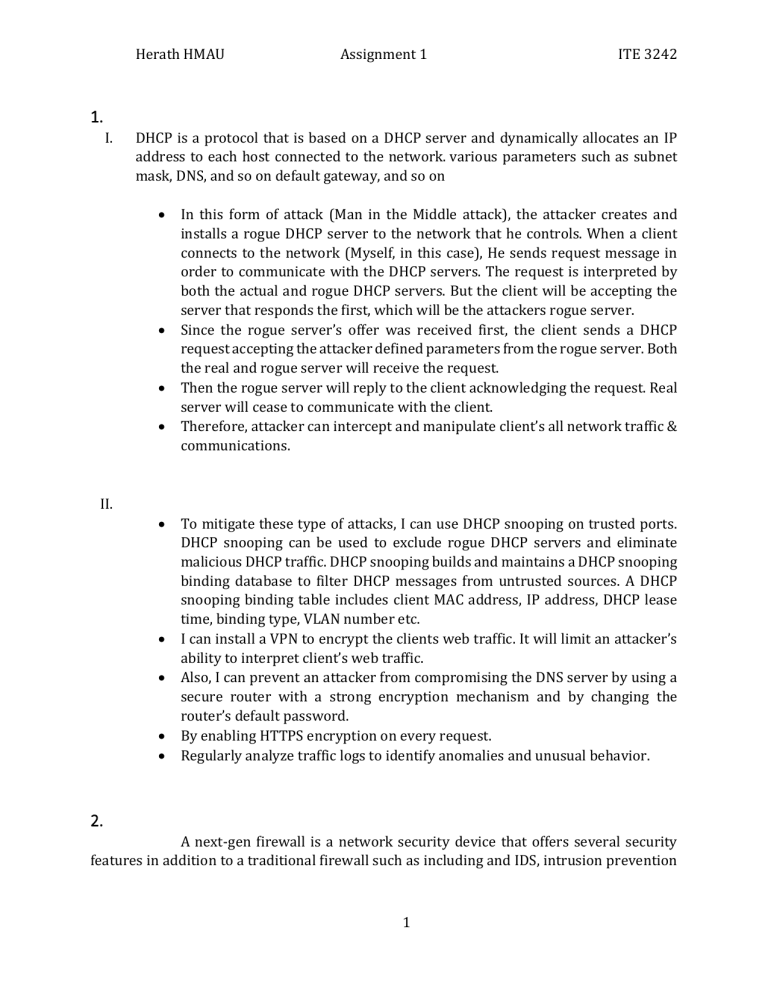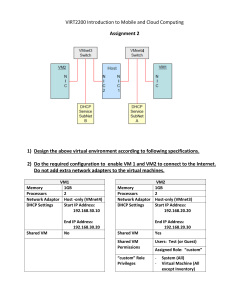
Herath HMAU Assignment 1 ITE 3242 1. I. DHCP is a protocol that is based on a DHCP server and dynamically allocates an IP address to each host connected to the network. various parameters such as subnet mask, DNS, and so on default gateway, and so on • • • • In this form of attack (Man in the Middle attack), the attacker creates and installs a rogue DHCP server to the network that he controls. When a client connects to the network (Myself, in this case), He sends request message in order to communicate with the DHCP servers. The request is interpreted by both the actual and rogue DHCP servers. But the client will be accepting the server that responds the first, which will be the attackers rogue server. Since the rogue server’s offer was received first, the client sends a DHCP request accepting the attacker defined parameters from the rogue server. Both the real and rogue server will receive the request. Then the rogue server will reply to the client acknowledging the request. Real server will cease to communicate with the client. Therefore, attacker can intercept and manipulate client’s all network traffic & communications. II. • • • • • To mitigate these type of attacks, I can use DHCP snooping on trusted ports. DHCP snooping can be used to exclude rogue DHCP servers and eliminate malicious DHCP traffic. DHCP snooping builds and maintains a DHCP snooping binding database to filter DHCP messages from untrusted sources. A DHCP snooping binding table includes client MAC address, IP address, DHCP lease time, binding type, VLAN number etc. I can install a VPN to encrypt the clients web traffic. It will limit an attacker’s ability to interpret client’s web traffic. Also, I can prevent an attacker from compromising the DNS server by using a secure router with a strong encryption mechanism and by changing the router’s default password. By enabling HTTPS encryption on every request. Regularly analyze traffic logs to identify anomalies and unusual behavior. 2. A next-gen firewall is a network security device that offers several security features in addition to a traditional firewall such as including and IDS, intrusion prevention 1 Herath HMAU Assignment 1 ITE 3242 system (IPS), a TLS/SSL proxy, web filtering, Bandwidth throttling, cloud-delivered threat intelligence, VPN etc. Traditional legacy firewall Next-gen firewall Provides partial application visibility and Provides full application visibility and control application control Only works with layer 2-4 Doesn’t support awareness application Works with layer 2-7 level Supports application level awareness Cannot decrypt and inspect SSL traffic Can decrypt and inspect both inbound and outbound SSL traffic Integrated intrusion protection system IDS and IPS are fully integrated with the (IPS) and intrusion detection system (IDS) next-gen firewalls are separate. Performance of NAT, VPN and stateful protocol inspection Proactive against internet threats Restricting web and web application use based on the reputation of the site 3. • Fencing and Barricades Physical barriers are the outmost layer of security and they are publicly visible. A perimeter system typically consists of perimeter fence system, security gate system, Bollards, vehicle entry barriers, guard shelters. These type of security systems need regular maintenance. Regular fence inspections are needed. It is important that not to park vehicles too close to a fence system. It can assist an intruder to climb over the fence. A typical fence system use following rules. o 1 meter – only deter casual trespassers o 2 meters – too high to climb by casual trespassers o 2.5 meters – offer limited delay to a determined intruder • Biometrics Biometrics are the automated methods of recognizing an individual based on a physiological or behavioral characteristic. They include measurements of the face, 2 Herath HMAU Assignment 1 ITE 3242 fingerprints, hand geometry, iris, retina, signature and voice. Biometrics provide confidential financial transactions and personal data privacy. Accuracy, speed, acceptability to users, resistance to counterfeiting, reliability, data storage requirements, enrollment time etc. are some of the important factors to consider when designing a biometric system. • Badges and Access Logs An access badge allows an individual to gain access to an area with automated entry points. An entry point can be a door, a turnstile, a gate or a barrier. They use various technologies such as magnetic stripes, barcode or biometrics. A card reader is used to read a number on an access badge then the system sends that number to a computer where, it makes access control decisions based on the credentials provided. The system logs each transaction and it can report entry details at later time. • Guards and Escorts Security guards are the best solution for access control when a situation requires immediate and appropriate responses. Guards control access to an organization’s most sensitive areas like in highly secure information system facilities. However, it is costly to use guards and not suitable for monitoring and recording high volume of traffic because humans make errors often. • Video and Electronic Surveillance These are a solid replacement for security guards in some cases. There are several advantages of using video & surveillance systems such as the ability to monitor places where no guard or personnel are present, they can record the data for long periods and have the ability to incorporate motion detection and notification. They are more accurate in capturing events after they have occurred. And it is economical to implement compared to guards. • RFID (Radio Frequency Identification) and Wireless Surveillance The use of RFID asset tags can be a great value to the security staff. An organization can place RFID readers in the door frames of secure areas so that they aren’t visible to individuals. 3






